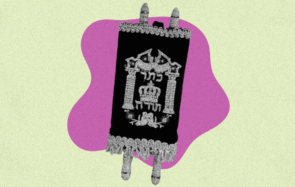Congratulations, it’s a boy! Now you have eight days to plan a bris.
Actually, this is not as hard as it sounds. The mohel you choose will tell you almost everything you need to know. Today you can even find one over the Internet–indeed, you can learn enough about planning a bris from the websites of various mohalim (plural for mohel) that by the time your research is done, you’ll be ready for everything but the actual cutting.
Timing
The bris is held on the eighth day of the baby’s life, and is frequently held in the morning. The Jewish day begins in the evening of the previous day. For example, if your son was born late Tuesday night, his bris will be scheduled for the Wednesday of the following week.
A bris is one of those rare Jewish life cycle rituals that can, and in fact, on occasion, must, be performed on a Shabbat or festival, even Yom Kippur; eight days is eight days. However, if the bris needs to be postponed because of the baby’s health, the rescheduled event cannot take place on a Shabbat or festival. If it cannot happen on the eighth day, the timing is no longer considered sufficiently imperative to risk the violations of traditional Shabbat practices that could potentially be involved.
The mohel will examine the baby to certify that he is healthy enough to undergo the procedure (unless a doctor has decided he is not). If he isn’t, it will be postponed to a later date. As usual in matters of physical health, Judaism takes a cautious approach, and mohalim are generally more strict on this issue than doctors.
Location, Location, Location
Perhaps the first decision you have to make is where to hold the ceremony. There is ample precedent for having a bris in the synagogue, in the context of daily morning services, if you so choose. The main argument against using the synagogue rather than your home is that it involves unnecessarily moving the baby around, which may be unsettling for a newborn (and more work for you!). If your home is large enough, you may choose to host it there. The mohel can even do the circumcision in the hospital on the eighth day, should there be health considerations that aren’t serious enough to postpone the circumcision altogether but which would be helped by this setting.
Finding a Mohel
Finding a mohel is both easier and more complicated than it was, say, a century ago. Back then, you would have used the local mohel without too much thought. Today, your options are considerably expanded, with mohalim available from all the major streams of Judaism, including an ever-growing number of MDs who are also trained as mohalim. Your local rabbi and Jewish friends who have had boys can recommend a mohel to you.
The Internet can also jumpstart your search with listings of mohalim in your area or nationally. The Reform movement has become much more active in promoting bris as a ritual observance and maintains a directory of Reform mohalim and mohalot (the female version).
Which Mohel is Right for Me?
Given this wealth of choices, it is important to know what questions to ask before you select a mohel. While you may simply choose a qualified and skilled mohel on the basis of recommendations (many people do), you may well want to ask him or her many of these questions for your own knowledge.
Once you’ve found a mohel, you also have someone who can answer many of your questions about preparing your house or synagogue for the bris. If you are planning to have many guests, the mohel may be able to suggest a caterer, a photographer, and even a Jewish calligrapher who can do a certificate commemorating the event.
All mohalim have their own requirements and guidelines for what happens during the ceremony and it would be wise to be guided by them, but certain elements are standard.
The Key Players
A minyan (quorum of 10) is customary but is not necessary for a bris. The mohel can, if need be, perform the rite with only the presence of the father and the sandek, the person (usually a grandparent) who holds the baby while the circumcision is performed. You may want to have a kvatter and/or kvatterin (plural), the person or people who carry the baby in.
Supplies
The bris is a cause for celebration and should be treated that way. You may want to decorate the house or synagogue with flowers or candles. While you will probably want to provide a festive table of food for your guests (the meal after a bris is considered a seudat mitzvah, a meal with sacred status), at a minimum you will need a loaf of challah or other bread (or two if it is Shabbat or a holiday), kosher wine, and a kiddush cup. You may want to provide kippot (head coverings) for those who wish to wear them.
Although the mohel will give you more precise instructions, the basics you will need are a washcloth and several disposable diapers, a sturdy waist-high table that won’t wobble, another table for the mohel’s instruments, a pillow, Vaseline or other petroleum jelly, Neosporin or other disinfectant ointment (as instructed by the mohel), and infant Tylenol or its generic equivalent. Make sure the room in which the bris is taking place is well-lit.
Dress for Success
The baby should be dressed in something that can be easily and completely pulled up above his waist and then lowered again. You should have a pacifier handy as well. Different mohalim have varying opinions on whether to feed the infant before the bris. It may help keep him calm, but it also means that he has a full stomach and may, though rarely, vomit if upset by having his legs held apart.
Ceremony Basics
The ceremony itself, without any additions, takes about 15 minutes, although the surgical procedure occupies only a small part of that time. After the procedure, a blessing over wine is recited and the baby is given his Hebrew name. Often the father and mother will offer a few words about the significance of the name they have chosen.
Finally, as is the case with most joyous lifecycle events, everyone joins in the seudat mitzvah (festive meal). While guests may wish to admire the baby, in reality he will often be eating or sleeping after the ceremony. The mohel will give you instructions for caring for the baby in the days after the circumcision.
For more essential tips, check out these do’s and don’ts from an experienced mother of three boys.








